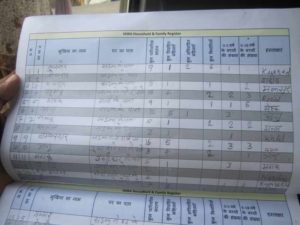The second mode of MIRA is called ‘MIRA Worker Toolkit’ with content, communication and service provisioning through the MIRA phones. ZMQ has set up a chain of health workers called MIRA workers who go from house-to-house to do household registrations and identify pregnant women and under 5 year children for RI (routine immunization) using mobile phones. After registering the pregnant women, MIRA visits the women regularly on a weekly basis and advises them through mobile phone based iconic graphic and audio which pertain to the current pregnancy week of the women. The data of pregnant women and children for immunization collected by MIRA workers is sent over the mobile to central server and is shared with local PHCs.
Each MIRA worker works in a village with a population of 1,000 to 1,200 people. She works like an ASHA where she maps the households, registers them and identifies each and every household with pregnant women, children from 0-5 years of age and adolescent girls. She has to visit the pregnant women every week and provide relevant information pertaining to that week. MIRA also trans communities on immunization and counsels adolescent girls on issues related to menstrual hygiene, emergency contraception, education, marriage, reproductive & sexual health, women rights etc. The majority of the content provided for adolescent girls is provided through games and story-telling.
MIRAs are trained by TOTs and are in touch with their local ASHA workers in the village. MIRA workers are usually young girls and are selected based on two main criteria. The first criterion is their educational qualification. They should be minimum school pass out. Secondly they should be from the same village. This gives her more access to the communities and easier to communicate and work. Thirdly they should have the passion to change the work. A MIRA worker is provided with adequate tools to reach out to people. She has a standard Java phone with connectivity which has the MIRA toolkit uploaded. She carries MIRA register with a village map, badge, dress and necessary stationary. They are also provided a monthly salary.
Under this model, currently ZMQ have 50 MIRA workers on-ground in Mewat. There are 10 MIRAs in each block of Mewat, which has one of the highest MMR and IMR indicators across all the districts in India. MIRA is an ideal model to demonstrate to the state health missions to use this for their ASHA workers. ZMQ is currently negotiating in the states of Madhya Pradesh and Rajasthan to replicate this model.
The concept of MIRA has recently been highlighted by Euro News TV Channel in Europe and US. The link is:
https://www.youtube.com/watch?v=v38PuEk-99c




